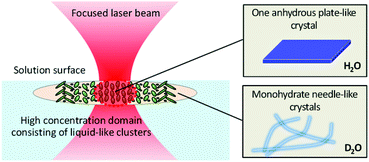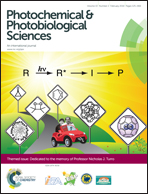Laser trapping-induced crystallization of l-phenylalanine through its high-concentration domain formation†
Abstract
We present the laser trapping-induced crystallization of L-phenylalanine through high-concentration domain formation in H2O and D2O solutions which is achieved by focusing a continuous-wave (CW) near-infrared laser beam at the solution surface. Upon laser irradiation into the H2O solution, laser trapping of the liquid-like clusters increases the local concentration, accompanying laser heating, and a single plate-like crystal is eventually prepared at the focal spot. On the other hand, in the D2O solution, a lot of the monohydrate needle-like crystals are observed, not at the focal spot where the concentration is high enough to trigger crystal nucleation, but in the 0.5–1.5 mm range from the focal spot. The dynamics and mechanism of the amazing crystallization behaviour induced by laser trapping are discussed from the viewpoints of the concentration increase due to laser heating depending on solvent, the large high-concentration domain formation by laser trapping of liquid-like clusters, and the orientational disorder of molecules/clusters at the domain edge.

- This article is part of the themed collection: Dedicated to the memory of Prof. Nicholas J. Turro

 Please wait while we load your content...
Please wait while we load your content...